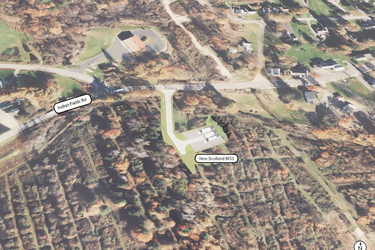BESS failures in decline
NEW SCOTLAND — Residents both wary and amenable to the idea of a large-scale battery energy storage system proposed for Indian Fields Road in Feura Bush will soon have a chance to voice either concern or support during an Oct. 7 public hearing.
In the last decade, the number of BESS in the United States has increased exponentially — from 50 in 2015 to 820 now, yet the number of failures has not increased; in fact, it decreased to just five worldwide last year.
The New Scotland Planning Board will hear comments on RIC Energy’s request to place an approximately 11,300-square-foot, five-megawatt storage system on seven secluded acres of the 137-acre New Scotland Beagle Club.
The installation would involve five batteries, each measuring eight feet high by six feet wide and 30 feet long. The system absorbs solar energy during the day, when both demand and payments from utility providers for the commodity are lower than during peak-use evening hours, when electricity from the battery storage system is sent to the grid.
The project is the first for the town since adopting energy-storage regulations in April 2024. And yet, it’s already been eclipsed by a proposal from New Leaf Energy to install two storage facilities on separate Wormer Road properties owned by Councilman Adam Greenberg.
Concerned about how battery energy storage systems, known as BESS, are perceived, the planning board has reviewed the project exhaustively.
Failures decrease
The reputation of battery-storage facilities suffered from a series of high-profile disasters, like the one at the 250-megawatt Gateway Energy Storage facility in San Diego that caught fire on May 15 of last year and wasn’t deemed extinguished until May 31, or the Moss Landing Power Plant 95 miles from San Francisco, reputed to be the largest BESS in the world, that ignited one day in mid-January, was put out by the following day, only to reignite a month later because of batteries buried beneath the rubble of the Jan. 16 fire.
During the spring and summer of 2023, three “failure incidents” occurred across New York state, from the eastern end of Long Island, through the Hudson Valley, all the way to the Canadian border where the Saint Lawrence River meets Lake Ontario, 80 miles north of Syracuse.
The incidents led Governor Kathy Hochul in July of that year to set up a task force of employees from five different state departments and divisions to suss out the root cause of the fires. The recommendations made by the Fire Safety Working Group have since been integrated into the latest version of the state fire code.
While there have been a number of national BESS-related news stories of late, there’s also a case to be made that energy-storage systems have fallen victim to the Yellow Car Phenomenon, the idea that once something is brought to your attention, you start noticing it more often, making it seem like it’s appearing everywhere.
BESS really are everywhere, but the actual number of storage sites experiencing a catastrophic failure has, on an annual basis, remained largely unchanged since wide-scale installation began in earnest about 10 years ago.
An oft-cited database maintained by one of the country’s premier independent, not-for-profit research and development organizations says that, between 2015 and 2024, there were approximately 100 failure incidents at storage facilities.
The Electric Power Research Institute goes by the Federal Emergency Management Agency’s definition of a failure incident, which is determined to be an “occurrence, natural or manmade, that necessitates a response to protect life or property … the word ‘incident’ includes planned events as well as emergencies and/or disasters of all kinds and sizes.”
The annual frequency of failure events began with just four at BESS in 2015 and increased every year until 2020, when EPRI recorded its highest-ever incident count for a single year, 20 failures. From 2021 to 2024, the annual number of failure incidents went from 12 to 14, back down to 10, and ended at five in 2024.
Now, there are two important pieces of information missing from the previous paragraph: First, the number of failure incidents recorded between 2015 and 2024 was a world-wide count; only about a third took place in the United States, and second, the country in 2015 had about 50 power plants with a total utility-scale battery storage capacity of 294 megawatts.
For comparison, the United States finished 2024 with a cumulative capacity 88 times greater, over 26,000 megawatts, than it did in 2015. As of this month, there are approximately 820 power plants whose total operating capacity is almost 35,000 megawatts.



